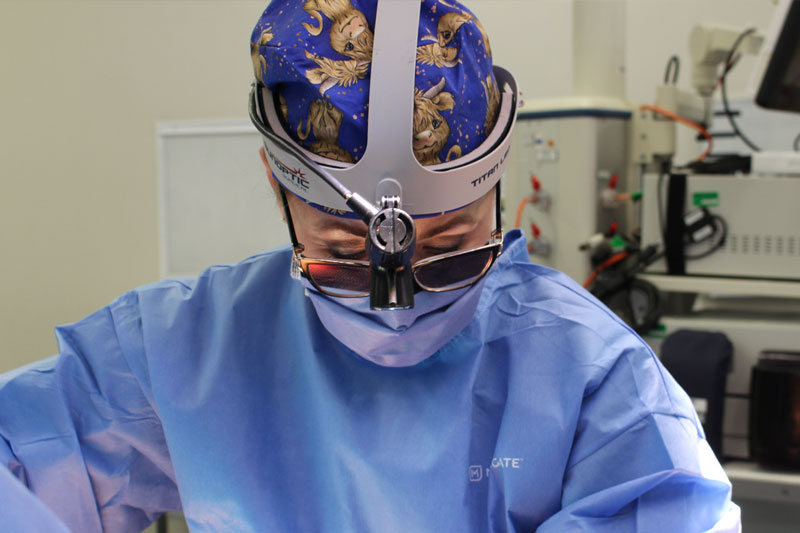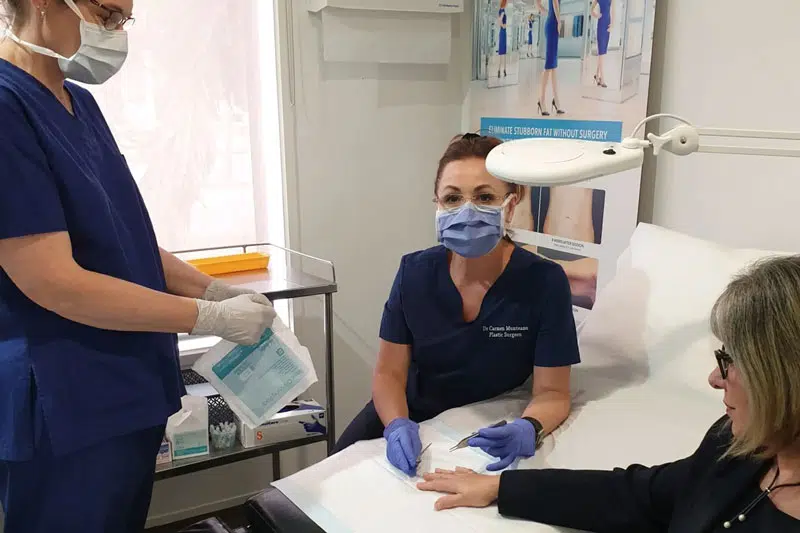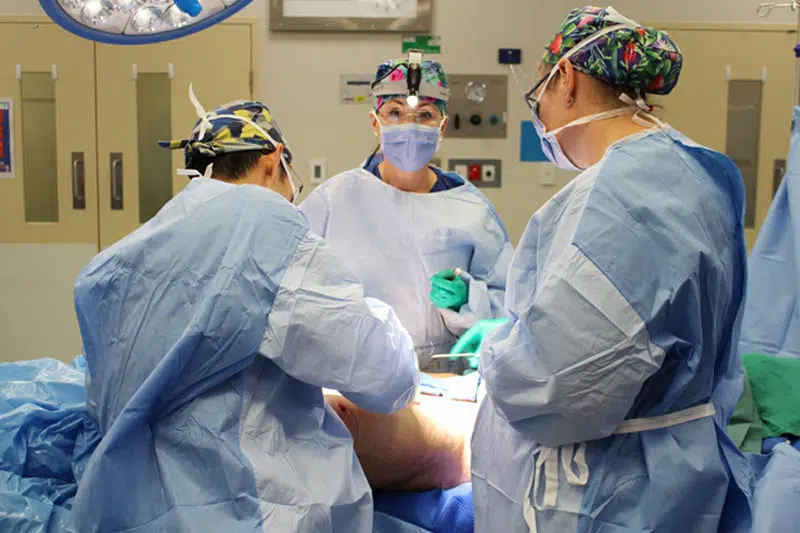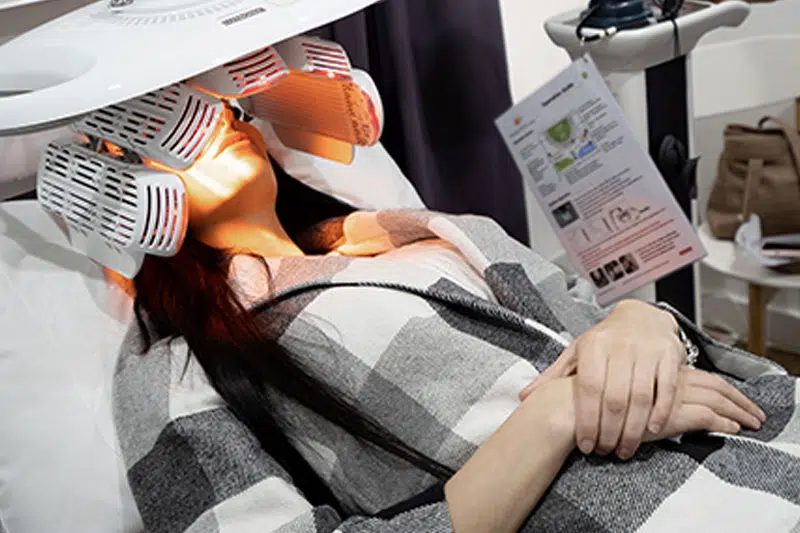How to Minimise Scars after Abdominoplasty
An abdominoplasty is a complex procedure that leaves behind scars, just like any other surgical intervention. Considering the fact that the scars after tummy tuck-abdominoplasty could be quite large, many patients are interested in techniques to reduce scars after tummy tuck-abdominoplasty. In this blog we will discuss what a tummy tuck-abdominoplasty is, the healing stages of a tummy tuck-abdominoplasty scar and effective tips for reducing your tummy tuck-abdominoplasty scar.
Melbourne Specialist Plastic Surgeon Dr Carmen offers a range of plastic surgery procedures. She regularly performs tummy tuck-abdominoplasty procedures, breast reduction, breast lift, breast implant surgery, and body contouring surgery. With over 25 years of experience in plastic surgery, Dr Carmen performs a wide range of procedures including tummy tuck-abdominoplasty, breast surgery, and body contouring.
Take our Plastic Surgery Quiz to find out if you’d be a good candidate and if you are ready for cosmetic surgery.
What Is a Tummy Tuck-Abdominoplasty?
A tummy tuck, or abdominoplasty, is a surgical procedure designed to remove excess skin and fat from the abdomen. It’s often chosen by individuals who have experienced significant weight loss or pregnancy, resulting in loose skin that can’t be toned through exercise alone. The procedure helps to create a smoother, firmer abdominal profile in some patients, depending on individual healing and anatomy.
The surgery involves making an incision across the lower abdomen from hip to hip. Dr Carmen will then remove excess skin, tighten the underlying muscles, and finally close the incision, leaving a scar. The length and visibility of this scar depend on several factors, including your body’s healing process, the surgical technique used, and how well you take care of your scar post-surgery.
Healing Stages of a Tummy Tuck-Abdominoplasty Scar
In the first few days post-surgery, your scar will likely appear red and swollen. This is a normal part of the healing process, as your body works to repair the surgical wound.
In the following weeks, your scar will begin to flatten and lighten in colour. During this stage, it’s essential to protect your scar from the sun, as exposure to UV rays can cause darkening and discolouration. Also, make sure to keep the scar clean and dry to prevent infections.
As your scar continues to heal over the next several months, it will become less noticeable. However, it’s important to note that full healing can take up to a year or more, and even then, your scar will still be visible.
20 Tips for Reducing Tummy Tuck-Abdominoplasty Scars
These tips range from maintaining a healthy lifestyle to incorporating specific scar management techniques into your daily routine.
- Follow Post-Operative Instructions: Adhere to your surgeon’s instructions post-surgery. This may include wound care, bathing instructions, and activity restrictions
- Quit Smoking: Smoking can hinder the healing process, which may lead to more noticeable scarring and wound breakdowns
- Stay Hydrated: Keeping your body hydrated can help improve skin elasticity and promote healing
- Eat a Balanced Diet: A balanced diet rich in proteins, vitamins, and minerals can enhance your body’s healing ability
- Avoid Sun Exposure: Protect your scar from the sun as UV rays can darken the scar and impede healing
- Use Scar Creams: Apply scar reduction creams as recommended by Dr Carmen to improve the scar’s appearance
- Massage the Scar: Gentle massage can help to break down scar tissue and improve blood flow to the area
- Wear Compression Garments: These can help to reduce swelling and support healing
- Stay Active: Gentle exercises can improve circulation and promote healing
- Avoid Heavy Lifting: This can strain the abdominal muscles and affect the scar’s healing
- Monitor for Infections: Look out for signs of infection like redness, excessive pain, or pus, and seek medical help immediately if you notice any
- Limit Alcohol Consumption: Alcohol can dehydrate the skin and impair the healing process
- Get Plenty of Sleep: Adequate rest can boost your body’s ability to heal
- Be Patient: Healing takes time. Don’t rush the process
- Use Silicone Sheets: Silicone sheets can help to flatten and fade scars
- Maintain a Healthy Weight: Avoid drastic weight changes that can stretch the scar and make it more noticeable
- Keep the Scar Clean: Regularly clean the scar with mild soap and water to prevent infections
- Use Vitamin E: Regular application of Vitamin E oil can promote healing and reduce discolouration
- Avoid Irritating the Scar: Don’t pick or scratch the scar as it heals
- Consult Your Plastic Surgeon: If your scar isn’t improving as expected, seek professional help
Download Dr Carmen’s Guide to Cosmetic Surgery Recovery
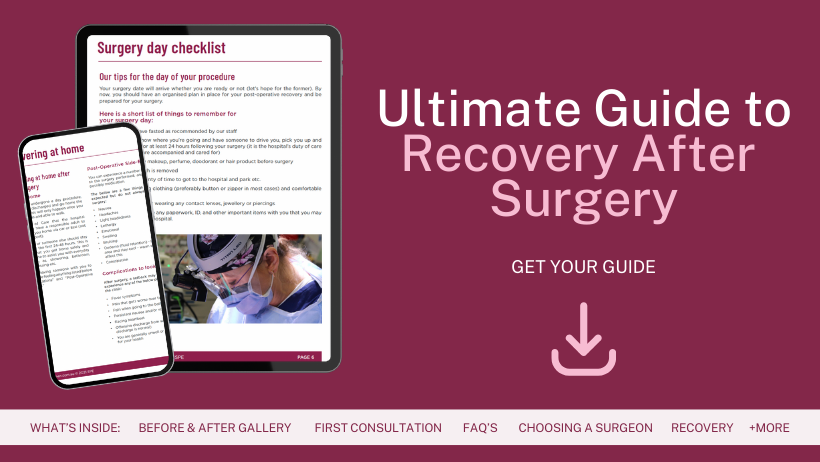
Diet and Hydration after Abdominoplasty
Nutrition plays a vital role in scar healing. A diet rich in proteins, vitamins, and minerals can enhance your body’s healing capacity. Include foods like lean meats, fish, eggs, nuts, and seeds for protein. For vitamins and minerals, consume plenty of fruits and vegetables, particularly those rich in vitamin C and zinc, which are essential for wound healing. Also, remember to drink plenty of water to stay hydrated and support your skin’s health.
Staying hydrated can help improve the elasticity and resilience of your skin, aiding in scar reduction. It helps to flush toxins out of your body and keep your skin cells healthy. Aim to drink at least 8 glasses of water per day. Avoid beverages high in sugar and caffeine, as these can lead to dehydration.
Exercise and Massages after Abdominoplasty
While strenuous activities and heavy lifting should be avoided immediately after your surgery, gentle exercises can help promote scar healing. Once Dr Carmen gives the go-ahead, start with low-impact exercises like walking. This can improve blood circulation, bringing more oxygen and nutrients to your wound to support healing.
Massaging your scar can help break down scar tissue and improve the scar’s appearance. It can also increase blood flow to the area, promoting healing. Once your incision has fully healed, you can start gentle massage using a scar cream or oil. Remember to always check with Dr Carmen before starting any new treatment.
Download Dr Carmen’s Guide to Tummy Tuck Surgery – Abdominoplasty

Other Scar Reduction Techniques
Apart from the tips mentioned, other techniques can help reduce your tummy tuck-abdominoplasty scar. These include laser therapy, which uses light to break down scar tissue, and microneedling, which stimulates collagen production to improve the scar’s texture and color. It’s crucial to consult Dr Carmen before trying these techniques.
In many cases, tummy tuck-abdominoplasty scars become flatter and lighter over time, although outcomes vary for each individual. It may still be visible, but with proper care and management, it can be significantly less noticeable. Remember, every person’s healing process is different, and it’s important to have realistic expectations.
In conclusion, managing your tummy tuck-abdominoplasty scar effectively involves a combination of healthy lifestyle habits, specific scar care techniques, and patience. It’s important to follow Dr Carmen’s post-operative instructions, maintain a balanced diet, stay hydrated, and protect your scar from the sun.
FAQs about Scars after Tummy Tuck – Abdominoplasty

How long does it take for tummy tuck scars to heal?
- The healing time for tummy tuck-abdominoplasty scars can vary from person to person. In general, the initial healing phase takes around two weeks. During this time, you may experience some swelling, redness, and discomfort. It’s important to note that complete scar healing can take several months to a year. During the first few weeks, Dr Carmen may recommend wearing a compression garment to support the healing process and minimize swelling. As the weeks and months pass, the scars will gradually fade and become less noticeable. It’s important to follow Dr Carmen’s instructions.
Can I do anything to speed up the scar healing process?
- While you can’t necessarily speed up the scar healing process, there are steps you can take to promote healthy healing and potentially minimise scarring. This includes keeping the incision area clean and dry, avoiding excessive sun exposure, and following any recommended scar care routines. Maintaining a healthy lifestyle can also contribute to better healing. Eat a balanced diet rich in vitamins and minerals, stay hydrated, and avoid smoking and excessive alcohol consumption. These factors can all support your body’s natural healing processes and potentially lead to improved scar healing.
Will I be left with noticeable scars after a tummy tuck-abdominoplasty?
- It’s important to understand that scarring is an inevitable result of any surgical procedure, including an abdominoplasty. However, the placement and size of the incisions are carefully planned to minimise the visibility of scars. Dr Carmen makes every effort to place incisions in locations that may be covered by clothing or swimwear, but scar visibility can vary depending on individual healing. Over time, with proper scar care and healing, tummy tuck-abdominoplasty scars tend to fade and become less noticeable.
Can I use over-the-counter creams or ointments to reduce tummy tuck-abdominoplasty scars?
- There is a wide range of over-the-counter scar creams, ointments, and gels available on the market. While some products claim to reduce the appearance of scars, their effectiveness varies, and not all of them have been scientifically proven to be beneficial. Before using any over-the-counter scar treatment, consider consulting Dr Carmen for personalized recommendations based on your specific case.
When can I start exercising after an abdominoplasty, and how will it affect my scars?
- The timing for resuming exercise after a tummy tuck-abdominoplasty depends on the individual and their healing progress. Generally, it’s important to avoid strenuous activities, heavy lifting, and vigorous exercises for at least six to eight weeks following the surgery. This allows your body sufficient time to heal and reduces the risk of complications. Once you have received clearance from Dr Carmen, you can gradually reintroduce exercise into your routine. Start with low-impact activities like walking and gradually progress to more intense exercises. It’s essential to listen to your body and avoid any movements that cause discomfort or strain on your incision site. Proper scar care and support during exercise, such as wearing a compression garment, can also contribute to scar healing.
Further Reading about Body Procedures and Recovery
- Read Dr Carmen’s blog about Recovery after Tummy Tuck – Tips, Timeline and FAQs after Abdominoplasty
- Read Dr Carmen’s blog about Recovery after Liposuction – Tips, Timeline and FAQs
- Read Dr Carmen’s blog about When Can I Exercise after Abdominoplasty Surgery
- Read Dr Carmen’s Tummy Tuck – Abdominoplasty surgery page
- Read Dr Carmen’s Liposuction & Liposculpture – Body Contouring surgery page
- Read Dr Carmen’s Blog about Preparing for Abdominoplasty Surgery
Medical References about Scar Treatment after Surgery
- Scar Treatments: Types of Scars and Their Treatments – WebMD
- Tummy Tuck: Timeline and tips – Medical News Today
- Reducing Scarring After Cosmetic Surgery – National Library of Medicine
- Scar Revision – Australian Society of Plastic Surgeons – Australian Society of Plastic Surgeons




